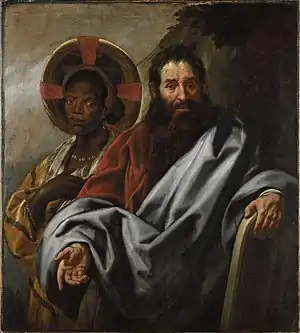Moses and his Ethiopian wife Zipporah
Moses and his Ethiopian wife Zipporah (Dutch: Mozes en zijn Ethiopische vrouw Seporah), c. 1645–1650, is a painting by Jacob Jordaens, a Flemish Baroque painter.[1][2] The painting is a half-length depiction of the biblical prophet Moses, and his African wife.
| Moses and his Ethiopian wife Zipporah | |
|---|---|
 | |
| Artist | Jacob Jordaens |
| Year | c. 1645–1650 |
| Medium | Oil on canvas |
| Movement | Flemish Baroque |
| Dimensions | 116.3 cm × 104 cm (45.8 in × 41 in) |
| Location | Rubenshuis |
Description
Moses stands in the foreground, with his left hand on the Tablets of Law. The tablets are in shadow, their contents unreadable. Behind him to his right stands his wife, a black woman—possibly Zipporah. The ribbons in her hat resemble a cross. The oil on canvas painting is kept at the Rubenshuis museum in Antwerp, Belgium.[3][4][5]:247
Inspiration
Book of Numbers 12:1 states that Moses was criticized by his older siblings for having married a "Cushite woman", Aethiopissa in the Latin Vulgate Bible version. One interpretation of this verse is that Moses' wife Zipporah, daughter of Reuel/Jethro from Midian, was black. Another interpretation is that Moses married more than once. Jordaens' view is unknown, and the painting has been exhibited under titles without the name Zipporah.[5]:248
Jordaens likely encountered the tale of Moses' wife in contemporary translations of the Bible and the writings of Josephus. Possibly he had also come into contact with the Jesuit Alonso de Sandoval's works on Africa. Contemporary artists who also included black women in their paintings probably inspired him too, such as Jan van den Hoecke's Sybil Agrippina.[5]:254, 274
The artist is likely to have made the painting not on commission, but for himself or a close friend.[5]:247
Interpretation
Art historian Elizabeth McGrath says that
Moses defends his black wife before the viewer, not his brother and sister. It is from the viewer that the Ethiopian woman draws back, questioning, puzzled and perhaps a little fearful. By his brilliant exploitation of the device of inclusion and confrontation, Jordaens gives the subject a pointed relevance, challenging Christians of his day to accept Moses's Ethiopian, as Miriam and Aaron could not, not just as a representative of pagan wisdom, a shadowed image of their own Church, but as a neighbour, in herself.[5]:282
Reference section
- "Jacob Jordaens (I)". Netherlands Institute for Art History.
- Smith Galer, Sophia (16 January 2019). "How black women were whitewashed by art". BBC. Retrieved 21 January 2021.
- Massing, Jean Michel (2010). The image of the Black in western art (New ed.). Cambridge, Massachusetts: Harvard University Press. p. 264. ISBN 9780674052710.
- "Mozes en zijn Ethiopische vrouw Seporah | Barok in de Zuidelijke Nederlanden | Een online museum". Flemish Art Collection.
- McGrath, Elizabeth (2007). "Jacob Jordaens and Moses's Ethiopian Wife". Journal of the Warburg and Courtauld Institutes. 70: 247–285. ISSN 0075-4390.
